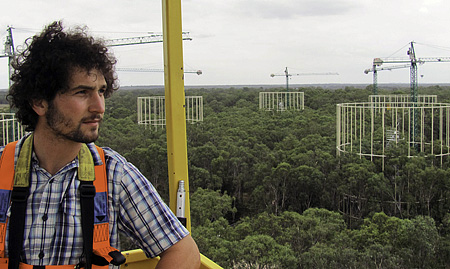Dr Vanessa Haverd speaking about CMAR’s carbon and climate research
Australia’s contribution to global carbon dioxide levels is largely through fossil-fuel emissions related to our export of coal, according to carbon expert Dr Vanessa Haverd.
‘Fossil fuel exports are one-and-a-half times our fossil fuel emissions,’ Vanessa told the large audience at the carbon sessions today at the 2013 TERN Symposium.
‘And that is after accounting for NBP [net biome production], which offset our fossil fuel emissions by 38%.’
‘We know that emissions from land-use changes have levelled off, and account for about 1% of Australia’s net primary production.’
Net primary production (NPP) is roughly the difference between the total photosynthesis and total respiration of plants in an ecosystem. Net biome production is the difference between carbon added to and carbon lost from a biome, or ecosystem, including from human disturbances and use.
Vanessa and her team at CSIRO Marine and Atmospheric Research (CMAR) have been modelling data to investigate Australia’s contribution to global carbon dioxide concentrations, and have been able to fine-tune the models to improve how well they predict.
‘We believe our work has significantly improved NPP estimates over earlier Australian studies and some global studies,’ she says.
Data streams made available through TERN’s OzFlux facility were critical to Vanessa’s work. Dr Helen Cleugh, the Director of OzFlux, highlighted the relevance of OzFlux and other TERN facilities in linking research to policy needs in an earlier presentation.
‘TERN’s infrastructure ‘ecosystem’ is offering the new capabilities needed to collect ecosystem data at continental scales to inform policy needs’, she says.
In another presentation at the carbon session, Professor David Ellsworth, at the Hawkesbury Institute for the Environment, described the EucFACE experiment he is conducting to measure how eucalypt woodlands might respond to an increase of carbon dioxide in the atmosphere.
‘Carbon dioxide experiments allow us to see where we’re going. They act as a sort of time machine, enabling us to see ahead of time in a real eucalypt forest what changes may occur due to increased atmospheric carbon,’ David says.
The research team will measure the response of Eucalyptus microcorys forest to carbon concentrations in the atmosphere of 540 parts per million (ppm), the amount that is predicted to be present by 2050. (The current concentration is about 390 ppm.)
‘We are using leaf nitrogen as a measure. It is a key ecosystem variable. Leaf nitrogen in canopies is relatively stable over time, and can be remotely sensed,’ David says.
The team had determined that they could get robust data by sampling two leaves on each of three trees in each measurement plot. As well as taking long-term measurements, the research team will investigate other variables from time to time, as opportunity presents.
‘Will we notice any changes from day-to-day environmental events, for example, the temperature spike of the 46° day we had at Richmond in January? We don’t know, but we’ll look at them.’
In a change of focus, Ms Susan Sweeney, from South Australia’s Department of Environment, Water and Natural Resources, talked about how the department is translating climate-change science supplied by TREND into policy.
‘There’s a perception in the department that climate-change research is not being used effectively,’ Susan says. ‘At the same time, we are also hearing concerns from our research partners that their research isn’t being taken up. That includes science specifically done for South Australia to drive policy.’
She described a workshop the department ran with TREND scientists to ensure that science and policy would work in a complementary way.
‘At the workshop we refined and prioritised some draft policy questions, with guidance from scientists as to what was realistically achievable from research,’ Susan says.
She said the workshop was invaluable in helping policy people understand the limits of science, and scientists understand the limits of how their work could be applied.
‘How do we translate the results into natural resource management policy and planning? We’re not there yet. We need to integrate with other climate-change research. And the information we get must be translated into explicit goals, targets and milestones.
‘Researchers have done a great job engaging with NRM planners, but we need to keep going. And of course it’s two-way.’
These presentations were just the tip of the iceberg in a full day of presentations about carbon and climate-related research being undertaken in Australia using TERN’s infrastructure. At the end of the day, it was clear that TERN is supporting new advances that are increasing Australia’s capacity to respond to complex policy challenges.
All presentations made at the TERN symposium will be available via the TERN web site after the symposium.
Published in TERN e-Newsletter February 2013 special science symposium coverage

EucFACE senior engineer Steven Wohl in a crane gondola above the canopy (Photo by Bek Christensen)







